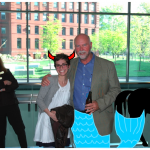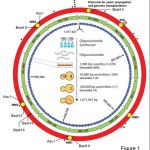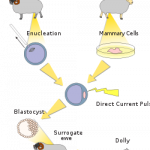genomics
The reaction to the Venter Institute's synthetic genome transplantation has been decidedly mixed. Is this the beginning of something new and wonderful, the ability to really design organisms from scratch? Is it something more sinister, the beginning of a dark era where techno-corporate (or terrorist) interests can design something that will destroy the environment in catastrophic ways? Is it just a technical advance or a conceptual breakthrough? A philosophical revolution? Is it a Big Deal or big whoop? Synthetic biology has never been just one thing and still has many different goals, with a…
The J. Craig Venter Institute has just announced the creation of the first bacterial cell controlled by a genome that is entirely chemically synthesized (PDF). The group has been working towards this goal for several years now, first working out how to synthesize and assemble such large pieces of DNA and how to transplant a genome from one organism to another. This result puts it all together, a synthetic version of the genome of the bacterium Mycoplasma mycoides and transplantation into a Mycoplasma capricolum cell. This synthetic cell is almost identical to a natural M. mycoides, but also…
Bits and pieces of an ongoing project to sequence the genome of the leafcutter ant Atta cephalotes have started going up on Genbank- Have a look!
Of course, these are just raw strings of nucleotides that haven't yet been annotated or analyzed in any meaningful way. The real science won't begin until researchers begin testing hypotheses against the data. But the raw material is there, and this is the first sequence from the ant genome projects to see the light of day. Exciting stuff!
A few calendar notes: I've got a three-day run starting next Sunday in which I'll be talking to authors and journalists about book proposals; NY science writers about the future of social media; and to genomic geeks about genes and temperament. If you've questions you'd like raised at any of these, please shoot me a note in the comments or privately at david.a.dobbs [at] gmail.com.
This Sunday morning, April 25, I'll be on a panel at the American Society of Journalists and Authors annual conference in New York discussing, along with agents Michelle Brower and Chris Parris-Lamb and GP Putnam…
New in vitro fertilization technology is making it possible for someone to have two moms--one that provides the genome in the nucleus of the cell, and one that provides the rest of the egg cell, including the mitochondria. Since all mitochondria are passed down from the mother in the egg (sperm are just too small to provide anything but the father's genetic material to the fertilized embryo), transplanting the nucleus from a fertilized embryo to an egg from a different woman can bypass the transmission of any mitochondrial diseases that the mother carries. Because mitochondria have their own…
Last week's issue of Nature focused on the progress (or lack thereof) in genomics and related fields since the Human Genome Project (HGP) was completed ten years ago. In many ways, the era of genomics has yet to fulfill many of the promises made twenty years ago, but the investment in science and technology has at the same time made a valuable impact on many fields in basic science. Understanding this recent history of the genomics bubble is crucial to how we approach current science and technology investments in areas such as personal genomics and importantly, synthetic biology.
In a…
After I wrote in my Atlantic article about getting my serotonin transporter gene assayed (which revealed that I carry that gene's apparently more plastic short-short form), I started getting a lot of email â several a week â from readers asking how to have their SERT gene tested. This led to an interesting hunt.
It was a hard question to answer. I couldn't just tell people to do what I did, for a psychiatric researcher/MD I'd known for years, who specializes in depression and serotonin, had done mine as a sort of favor to science and journalism. That researcher also stood by, had I needed…
When I'm not fighting the forces of evil or calling idiots who desperately need my help fucking morons, I'm doing various genomics-related things. One of the things I'm involved with is a project to sequence a bunch of commensal (not associated with disease) E. coli. When most people think of the genus Escherichia, they think of a single species, E. coli. But a recent paper describes five new lineages (clades) of Escherichia that, while found mostly in the environment, are also found in humans (and, yes, we're sequencing ten of these). Here's how they're related to each other:
UPMGA…
Another Hydrocalypse Industries original production, the Beard-ome presents imaginary work on the genomics of the beard. What's lying beneath your beard?
While I'm away, here's something from the depths of the Mad Biologist's Archives:
By way of ScienceBlogling Razib, I came across this Reason article by Ronald Bailey summarizing the presidential candidates views' on evolution. Bailey highlights two reasons what lack of support for evolution says about a candidate:
The candidate probably is weak on the separation of church and state.
The candidate is unable to rationally assess evidence.
But I think this misses the point entirely: evolution matters because evolutionary biology matters.
Granted this sounds like something Yogi Berra would…
from a different Daily Dish -- 365 petri dishes, by Klari Reis
House of Wisdom, the splendid new blog on Arabic science from Mohammed Yahia, editor of Nature Middle East describes an effort to map the Red Sea's coral reefs with satellite, aerial, adn ship-based technologies. Nice project and a promising new blog.
Brain and Mind
Ritalin works by boosting dopamine levels, says a story in Technology Review, reporting on a paper in Nature Neuroscience. The effect is to enhance not just attention but the speed of learning.
As several tweeters and bloggers have noted, H-Madness is a new group blog…
Daniel McArthur and Daniel Vorhaus have a beef:
Earlier this month, the Sunday Times published an op-ed piece by Camilla Long critiquing the practice and business of direct-to-consumer (DTC) genetic testing ("When DNA means do not ask"). It is Long's right, of course, to express her opinions, but the article is peppered with factual inaccuracies and exaggerations that demand correction.
...
While it is regretful that Long herself chooses to remain willfully ignorant of her own genetic information, she is within her rights to do so. However, her attempt to impose that ignorance on her…
Not Exactly Pocket Science is a set of shorter write-ups on new stories with links to more detailed takes by the world's best journalists and bloggers. It is meant to complement the usual fare of detailed pieces that are typical for this blog.
Geneticist sequences own genome, finds genetic cause of his disease
If you've got an inherited disease and you want to find the genetic faults responsible, it certainly helps if you're a prominent geneticist. James Lupski (right) from the Baylor College of Medicine suffers from an incurable condition called Charcot-Marie-Tooth (CMT) disease, which…
And how is it different than genome sequencing?
So recently, I've been hearing people outside of the field of genomics refer to "deep sequencing." I'm not sure what that phrase means: I would like to think that, in a philosophical sense, all of the sequencing we do is "deep" (dude). We certainly don't set out to do shallow, stupid, and superficial projects.
If deep sequencing means the depth of coverage--the number of times, on average, a nucleotide is sequenced--depending on the project's goals, the size of the genome, and so on, sometimes we sequence deeply, sometimes we don't.
This…
A new paper in PLoS, Rapid Assessment of Genetic Ancestry in Populations of Unknown Origin by Genome-Wide Genotyping of Pooled Samples:
Many association studies have been published looking for genetic variants contributing to a variety of human traits such as obesity, diabetes, and height. Because the frequency of genetic variants can differ across populations, it is important to have estimates of genetic ancestry in the individuals being studied. In this study, we were able to measure genetic ancestry in populations of mixed ancestry by genotyping pooled, rather than individual, DNA samples…
You are outnumbered by a factor of 10 to one, by forces you cannot see. Your body has around ten trillion cells, but it's also home to a hundred trillion bacteria. For every gene in your genome, there are 100 bacterial ones. Most of these are found the dark, dank environment of your bowel but their incredible diversity is being brought to the surface. Say hello to the gut metagenome.
Together with a team of international scientists, Junjie Qin and Ruiqiang Li from BGI-Shenzen had the unenviable task of studying the bacteria from the faeces of 124 Europeans. They used a formidable and…
As you know lactase persistence (LP), which confers the ability to digest lactose sugar as an adult, is an evolutionarily recent development. On the order of 1/3 of the human population exhibits LP, due to a variety of genetic mutations which seem to arise in the cultural background of the domestication of cattle. Some have asked about the possible associations between LP & height & weight before. A new paper in Human Molecular Genetics looks at just that, European lactase persistence genotype shows evidence of association with increase in body mass index:
The global prevalence of…
Acyrthociphon pisum, the Pea Aphid
The genome sequence of the pea aphid Acyrthosiphon pisum was published today in PLoS. Concurrently, a set of supporting papers has come out in Insect Molecular Biology. This genome is significant for a number of reasons- it's the first Hemipteran genome to be sequenced, aphids have an unusual reproductive cycle, and this particular species is a serious agricultural pest.
I've not had time to fully digest the paper, but it seems the salient features of this genome are:
extensive gene duplications
a higher gene count than most other known genomes (including…
Meet !Gubi, the tribal elder of a group of Bushmen (or Khoisan), one of the oldest known human lineages. He lives the life of a hunter-gatherer in the Namibian part of the Kalahari Desert. But he also has a strange connection to James Watson, the British American scientist who helped to discover the structure of DNA. For a start, they're both around 80 years old. But more importantly, they are two of just 11 humans to have their entire genomes sequenced.
Along with Archbishop Desmond Tutu, !Gubi is one of two southern Africans, whose full genomes have been sequenced by Stephan Schuster and…
Meet "Inuk". He is the ninth human to have their entire genome sequenced but unlike the previous eight, he has been dead for some 4,000 years old. Even so, DNA samples from a tuft of his frozen hair have revealed much about his appearance and his ancestry.
Inuk had brown eyes and brown skin. His blood type was A+. His hair was thick and dark but had he lived, he might not have kept it - his genes reveal a high risk of baldness. Inuk may well have died quite young. Like many Asians and Native Americans, his front teeth were "shovel-graded", meaning that their back faces had ridged sides and…


